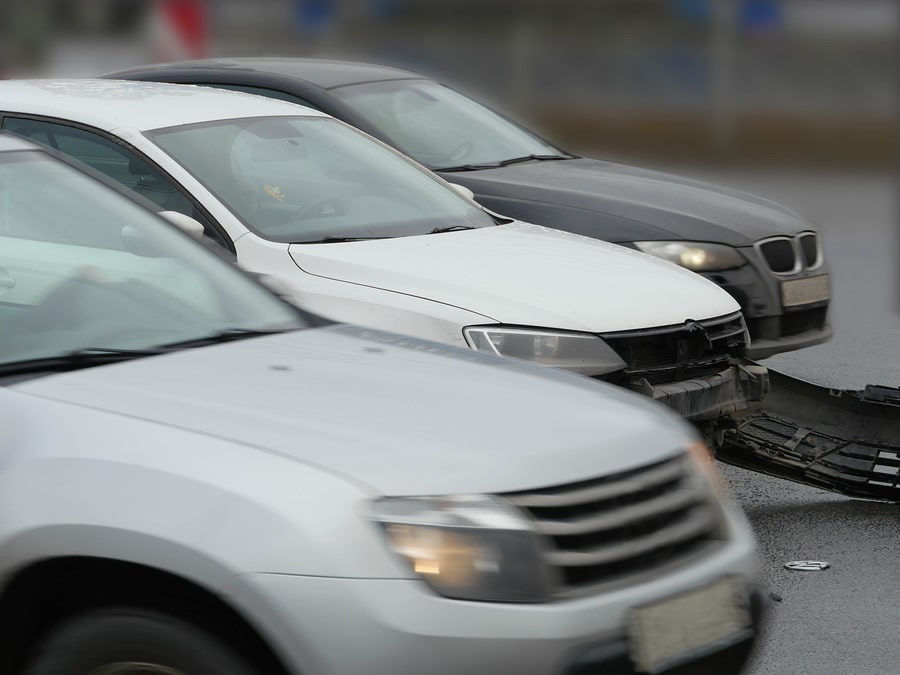
Motor vehicle collisions in the United States that occur on roadways, as well as in parking garages and parking lots, do not always involve just two vehicles. In some cases, three or more vehicles can contribute to an accident. Because one or more drivers involved in a three-car accident may have been at fault, it can be difficult to determine exactly who caused or contributed to the accident.
Anyone who causes or contributes to a motor vehicle collision could be considered responsible. For example, some states follow the law of joint and several liability, in which two or more negligent individuals are liable independently for the full amount of the accident victim’s damages, irrespective of each individual’s percentage of fault.
In other jurisdictions, where two or more individuals cause or contribute to an accident, the damages are split between the tortfeasors, according to their respective degrees of fault. If one or both of the other drivers were acting within the scope of their employment at the time of the accident, then an at-fault driver’s employer may be responsible for damages, under an agency theory of recovery.
If you or someone you love has been involved in a motor vehicle collision that involved three vehicles, an experienced car accident lawyer in your jurisdiction can help you investigate the circumstances of your accident and identify all of the individuals who may have caused it. Your lawyer can then assist you with bringing a personal injury claim or filing a lawsuit against all of these parties, in an attempt to collect monetary damages in your case.
Determining Which Driver(s) Caused or Contributed to Your Accident
It can be difficult sometimes to tell exactly how an accident occurred and which driver(s) caused or contributed to the accident. When it comes to determining who caused an accident in which three vehicles are involved, certain types of evidence can be extremely helpful.
Those types of evidence include the following:
- A police report prepared by an officer who investigated the accident scene – When a police officer arrives at the scene of the accident—especially a multi-vehicle collision—the officer will likely complete a police report which describes how the accident occurred, which driver or drivers caused the accident, and whether the officer issued one or more traffic citations following the accident (as well as to whom the officer issued those citations).
- Testimony of eyewitnesses of the collision – Eyewitnesses present at the time and place of the accident, and who saw what happened, can greatly aid the process of determining fault. For example, an eyewitness may state how many vehicles were involved in the collision, and which one(s) likely caused or contributed to the accident. An eyewitness to the accident may also testify about how fast a particular driver was traveling, and whether any of the involved drivers were driving erratically.
Responsible Motor Vehicle Drivers
The injured accident victim has the burden of proving negligence on the part of one or more of the involved drivers in a motor vehicle collision. The other drivers, on the other hand, are not responsible for proving anything.
For an injured car accident victim to prove that another driver caused or contributed to the collision, the accident victim must demonstrate all of the following legal elements regarding each driver who was potentially at-fault for the accident:
- The other driver acted in a manner that was unreasonable under the circumstances that existed at the time the accident occurred. For example, the at-fault driver did something that a reasonable driver would not have done—or failed to do something that a reasonable driver would have done under the circumstances. Speeding, running a red light or stop sign, or driving while intoxicated are all examples of driving in reckless, careless, and unreasonable manner, and amount to negligence in the context of a motor vehicle collision.
- The accident victim suffered one or more physical injuries as a result of the motor vehicle collision to which the at-fault driver caused or contributed.
- The accident victim’s physical injuries and damages were sustained in the three-car motor vehicle collision that involved the at-fault drivers.
A knowledgeable car accident attorney in your jurisdiction can assist you with recovering compensation from one or both of the at-fault drivers in your accident and/or the responsible driver’s insurance company.
Personal Injury Claims Based on Agency Law
In some instances, three-car motor vehicle collisions occur when one or both of the responsible drivers are on the job and acting within the scope of their employment. Depending upon the jurisdiction where the accident occurs, the law of agency might come into play under those circumstances.
Employers can be vicariously liable under an agency theory of recovery when their employee driver causes or contributes to a motor vehicle collision that occurs while the driver is on the job.
Additionally, employers have a legal duty to ensure that the individuals whom they employ will be responsible drivers and will drive company vehicles in a responsible, safe, and prudent manner at all times when on the road. In cases where a driver has a bad driving record, and the employer knows about the driver’s problematic past, then the employer may also be responsible for negligently hiring, retaining, or supervising the at-fault driver.
In jurisdictions that use joint and several liability for cases that involve multiple tortfeasors, an employer could be liable for some or all of the damages that an accident victim suffers at the hands of a negligent employee driver.
Injuries Suffered in a Three-Car Collision
Collisions that involve three or more vehicles may involve multiple impacts, such as in multi-vehicle pile-ups and chain-reaction collisions. Because of this, multi-vehicle car accidents can often result in very serious injuries. If one or both of the other motor vehicle drivers are at fault for the accident, each can be responsible for the injuries and damages which the accident victim suffers in the accident.
Some of the most common types of injuries that victims of three-car collisions may suffer include the following:
- Soft tissue injuries, including muscular contusions, sprains, and strains
- Traumatic head and brain injuries (TBIs), including concussions, brain contusions, or skull fractures, that may lead to more serious problems later on
- Injuries to the back or spinal cord, including partial or full paralysis
- Fractures and broken bones
- Death, in which case the surviving family members or the personal representative of the decedent’s estate may file a wrongful death claim or lawsuit against the responsible parties for the accident
If you have suffered one or more of these injuries in a three-car motor vehicle collision that was caused by other drivers, a skilled car accident attorney can bring a claim or lawsuit against all potentially responsible parties, helping you to pursue the compensation that you deserve for your injuries.
Recovering Monetary Compensation in a Three-Car Collision Case
When it comes to recovering monetary compensation in a motor vehicle accident that involved three or more vehicles, deciding who is responsible for covering the cost can be difficult to determine. In cases where a driver’s employer is also arguably at fault for an accident, the issue can become even more complicated.
A lawyer will handle joint tortfeasor liability in a three-car accident case differently, depending largely on the jurisdiction where the accident occurs and the laws that are applicable in that jurisdiction. Some jurisdictions, for example, use a form of joint and several liability. In those jurisdictions, each individual who causes or contributes to the motor vehicle collision may be responsible for all of the damages that the accident victim suffers, regardless of the responsible party’s share of the fault.
In other three-car motor vehicle accident cases that settle, the parties may agree upon the amounts that each party will pay as part of the settlement agreement. For example, if the settlement amount is $50,000, the parties may agree that each of the responsible parties will pay 50 percent—or $25,000 each—or that the settlement money will be paid out differently, based on each party’s percentage of fault for the collision.
An experienced car accident lawyer can guide you through the process and help you decide the best way of pursuing the maximum amount of monetary compensation against all potentially responsible parties in your accident case.
Types of Damages Available After a Three-Car Accident
As previously stated, the injuries that can result from a three-car motor vehicle collision can be serious. Depending upon the seriousness of the accident and injuries sustained, as well as the extent of the accident victim’s medical treatment, the accident victim can pursue monetary compensation for the at-fault tortfeasor(s), as well as the responsible tortfeasor’s motor vehicle insurer.
Some of the most common types of compensation that victims of motor vehicle collisions involving three vehicles may recover include:
- Out-of-pocket costs – Victims of three-car motor vehicle crashes are often forced to incur significant out-of-pocket costs. Those costs can include paying bills for medical procedures, medical treatment, and physical or occupational therapy. An accident victim may also need to miss time from work to recover from his or her injuries, or to attend a multitude of medical appointments and physical therapy sessions.
- Pain and suffering – A three-car collision can result in terrible injuries that may lead to inconvenience or unbearable pain and suffering. All of this is legally compensable.
- Permanent inability to work – In some three-car accident cases, the accident victim is injured to such an extent that he or she cannot go back to work at all, or in the alternative, may only go back to work by performing a light-duty job at a lower rate of pay.
- Emotional distress and mental anguish – Some three-car motor vehicle accidents are so traumatizing for accident victims that they can suffer from serious mental anguish, emotional distress, post-traumatic stress disorder (PTSD), and other psychological or psychiatric conditions. When a car accident victim must seek help from a mental health provider because of the experience of the accident and/or the injuries he or she sustained, then the accident victim deserves to be compensated.
- Loss of spousal companionship and support – Due to the injuries suffered in a motor vehicle collision, an accident victim may no longer be physically able for intimacy with his or her spouse. When that happens, the accident victim may file a claim for loss of spousal companionship and support—otherwise known as a loss of consortium claim.
An experienced motor vehicle accident lawyer near you will take all of the necessary legal actions to help you maximize the compensation that you legally deserve in your car accident case.
Never Hesitate to Find out How a Lawyer Can Help
It can be difficult to hash out fault and responsibility in multi-vehicle accident cases. The goal of your personal injury car accident lawyer is to assist you in becoming fully and fairly compensated for all of the injuries that you suffered in your car accident.
Contact a lawyer who can assist you with your accident case by first making a thorough investigation into the cause of your accident, such as speaking with witnesses and determining exactly how the collision occurred, and who was responsible. Next, your lawyer can work to help you pursue a favorable monetary recovery against any and all potentially responsible parties in your accident.
Finally, if the insurance company will not offer you the compensation that you feel you deserve for your injuries, you always have the option of trying your case in court before a jury or taking part in alternative dispute resolution proceedings, such as mediation or binding arbitration. These cases are particularly complicated, and multiple parties might be fighting liability, so you want qualified legal representation.














